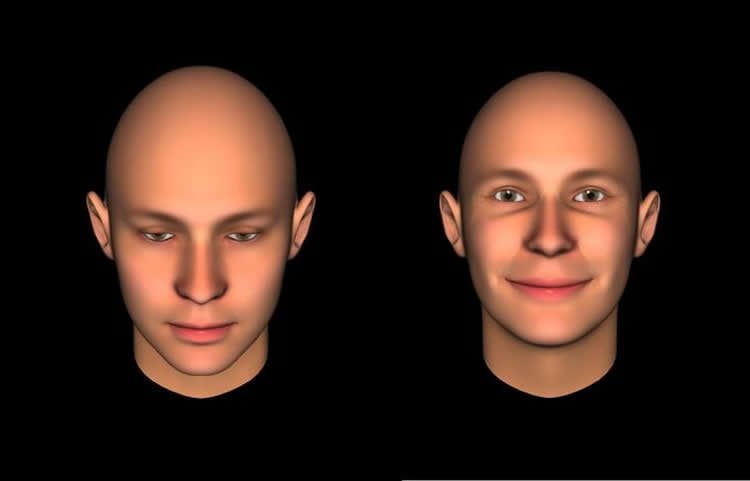Empathy, the ability to identify and understand other people’s emotions, has many components. Some are sophisticated and involve complex thought processes, while others are basic but essential nonetheless. The latter include joint attention – which is activated by direct eye contact between two or more individuals, and allows them to focus their attention on the same object; and facial mimicry – the tendency to reproduce on one’s own face the expressions of emotion seen in others. Subjects suffering from autism have difficulty with both these abilities. According to a new study just published in Autism Research, it is also important to study how these two functions interact.
“Empathy is an essential human trait in social relations”, explains Sebastian Korb, a researcher at the International School for Advanced Studies (SISSA) in Trieste and one of the study authors. “According to embodied cognition theories, to better understand the facial expression of the person in front of us we reproduce the same expression on our face”. This does not necessarily mean that if we see someone smiling we smile as well, even though this does happen sometimes. More often, however, the facial muscles involved in smiling are indeed activated, but so subtly that the movement is invisible to the naked eye.
The known difficulty autistic people have in interpreting other people’s emotions could stem from reduced facial mimicry. Many studies have demonstrated that this function is defective in these subjects. Other studies have shown that joint attention is also impaired in autism, and this is another function that has huge relevance for social interaction. Nevertheless, the impairments in facial mimicry and joint attention in autism remain controversial and poorly understood. For this reason, “we believe the interaction between these two abilities deserves plenty of attention”, explains Korb. “In our experiments, we saw that in persons with more pronounced autistic traits, joint attention tended to ‘disturb’ facial mimicry, whereas in normal subjects it facilitated it”.
A question of interaction
It should be noted that the 62 subjects who took part in the experiment were not individuals with a clinical diagnosis of autism. Instead, researchers used a questionnaire measuring the autistic tendencies of normal persons. In fact, it has been demonstrated that everyone has more or less autistic traits, although in most cases these tend to be mild and therefore do not lead to a diagnosis.

During the experiment, the subjects interacted with an “avatar”, a three-dimensional interactive face which responded to the subject’s gazing behaviour. At the beginning of each trial, the avatar looked down, but as soon as the subject’s gaze (monitored by means of an eye-tracking system) moved towards the avatar’s eye region, the avatar looked up and he could either make eye contact with the subject (condition of joint attention) or avert his gaze and look up (condition of no joint attention). Subsequently, the avatar shifted his gaze to focus on one of two objects to the side, while the eye-tracker recorded whether or not the subject’s gaze followed that of the avatar. At that point, the avatar could either smile or make an expression of disgust. During the trial, the subject’s facial mimicry was measured by facial electromyography (a method used for recording muscle activation).
“What we observed is that in conditions of joint attention and where the avatar smiled, the subjects with more pronounced autistic traits tended to show less activation of the major smile muscle, whereas those with milder or no autistic traits showed a much more amplified expressive response”, explains Korb. “Individuals without autism tend to display a stronger empathic response (and facial mimicry) to persons with whom they have established eye contact and joint attention. However, if the subject has autistic tendencies then the eye contact can disturb and diminish facial mimicry”.
“In order to understand both the mechanisms underlying normal social interaction and the altered processes involved in autism, it is therefore important to observe not only which functions are impaired but also how these functions work together”, concludes Korb.
Funding: The study’s co-author was Ben C.P. Lam of Iowa State University. The research was funded in part by a Humboldt Foundation award to Oyserman.
Source: Federica Sgorbissa – SISSA
Image Source: The image is credited to Sebastian Korb
Original Research: Full open access research for “Spontaneous Facial Mimicry is Modulated by Joint Attention and Autistic Traits” by Janina Neufeld, Christina Ioannou, Sebastian Korb, Leonhard Schilbach and Bhismadev Chakrabarti in Autism Research. Published online October 7 2015 doi:10.1002/aur.1573
Abstract
Spontaneous Facial Mimicry is Modulated by Joint Attention and Autistic Traits
Joint attention (JA) and spontaneous facial mimicry (SFM) are fundamental processes in social interactions, and they are closely related to empathic abilities. When tested independently, both of these processes have been usually observed to be atypical in individuals with autism spectrum conditions (ASC). However, it is not known how these processes interact with each other in relation to autistic traits. This study addresses this question by testing the impact of JA on SFM of happy faces using a truly interactive paradigm. Sixty-two neurotypical participants engaged in gaze-based social interaction with an anthropomorphic, gaze-contingent virtual agent. The agent either established JA by initiating eye contact or looked away, before looking at an object and expressing happiness or disgust. Eye tracking was used to make the agent’s gaze behavior and facial actions contingent to the participants’ gaze. SFM of happy expressions was measured by Electromyography (EMG) recording over the Zygomaticus Major muscle. Results showed that JA augments SFM in individuals with low compared with high autistic traits. These findings are in line with reports of reduced impact of JA on action imitation in individuals with ASC. Moreover, they suggest that investigating atypical interactions between empathic processes, instead of testing these processes individually, might be crucial to understanding the nature of social deficits in autism.
“Spontaneous Facial Mimicry is Modulated by Joint Attention and Autistic Traits” by Janina Neufeld, Christina Ioannou, Sebastian Korb, Leonhard Schilbach and Bhismadev Chakrabarti in Autism Research. Published online October 7 2015 doi:10.1002/aur.1573






